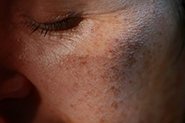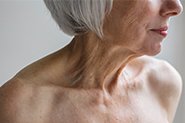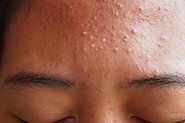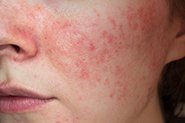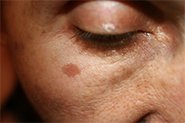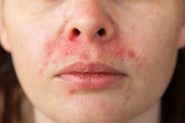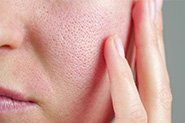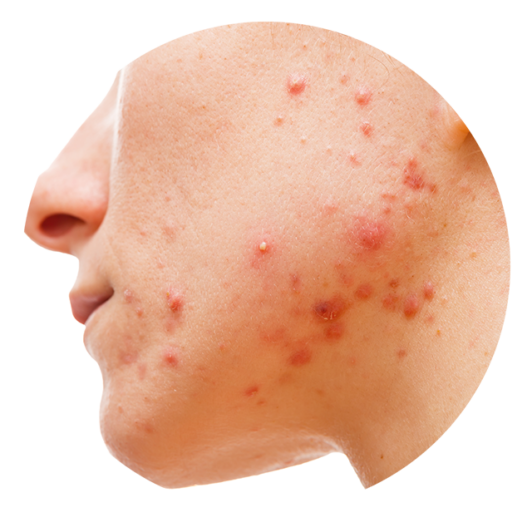

Written by Qr8 Clinical Lead Dr Ambi Sud
What is hormonal acne and what causes hormonal acne?
The term ‘hormonal acne’ is often referred to as something separate from ‘regular’ acne (‘acne vulgaris’), but the truth is that all acne is influenced by hormones, particularly hormones known as androgens.
Androgens are a group of sex hormones that include testosterone, that are produced in differing amounts in both males and females. While androgens are the main hormones linked to acne, other hormones—such as oestrogen, progesterone, and insulin-like growth factor 1—can also influence the skin and cause adult acne in females.
Androgens can increase oil (sebum) production in the skin which blocks pores – the first step in a pimple forming.
Some people have a higher than usual amount of these hormones circulating in their system, and / or their oil glands may be more sensitive to these hormones.
Hormonal imbalances where androgen levels are more dominant at varying times in the monthly cycle can also occur. Polycystic Ovarian Syndrome (PCOS) is a good example of such a condition.
Hormonal acne can also make an appearance (or reappearance!) during perimenopause and menopause as hormone levels fluctuate.
Hormonal imbalances may be detected using blood tests (biochemical tests) but there are often clues and signs for the doctor taking a full history and examining the patient (clinical) – another reason why a medical conversation about your skin and acne with a doctor trained in skincare is important!
Read more about skin changes and during perimenopause and menopause HERE >>
What Are The Signs and Symptoms of Hormonal Acne?
Some signs that show a person’s acne is more affected by hormones than usual include:
- Pimples with no head that feel deep under the skin (often described as cystic and / or nodular)
- In those who have periods, breakouts may be closely associated with the timing of their monthly cycle (typically worsening around 1 week before a period is due)
- A known diagnosis of PCOS
- Patients going through menopause or perimenopause where periods are fluctuating
- A doctor may identify some clinical signs, such as thick hair growth in unusual areas e.g. the face and neck, hair loss or balding and difficulty losing weight (to name but a few)
- Limited success with other acne treatments that do not target hormones
What’s The Best Treatment For Hormonal Acne?
Ingredients like Prescription Retinoids and Azelaic Acid, whilst they effectively treat the pathways that cause acne, don’t specifically target hormones.
Spironolactone is an anti-acne ingredient that blocks specific hormones (including androgens) – it can be taken as a tablet as part of acne treatment, however it can have side effects including low blood pressure and nausea when taken orally, so may not be suitable for everyone.
Topical Spironolactone for Hormonal Acne:
The benefit of using spironolactone in topical formula is that systemic side effects can be avoided, and the drug can work directly on the skin to produce its effect.
When used topically, spironolactone can reduce oil production and acne associated with excessively oily skin by blocking the action of hormones on oil glands.
Topical spironolactone is generally well-tolerated with very minimal side effects – a 2% topical formula has even been shown to be more effective than 1.5% topical clindamycin in reduction of acne lesions and severity.
Topical Spironolactone is not an over-the-counter acne drug – it’s available by prescription only after a medical assessment of your skin.
Spironolactone can also be combined with other anti-acne ingredients. For example, it is possible to combine it into a single cream with other topical acne medications such as prescription retinoids for a very effective treatment option. Chat to your Qr8 doctor about options for you during your video appointment.
Can Special Diets or Supplements Treat Hormonal Acne?
Unfortunately there is no scientific evidence that these have any effect on hormones or oil production.
What’s The Best Skincare Routine For Acne-Prone Skin?
If you are using prescription topicals, the key to great outcomes with minimal side effects is the right supporting dermocosmetics (cleanser, moisturiser and sunscreen). Your Qr8 Skin Plan will contain recommendations for products that will support your skin whilst using prescription skincare.
If you’re concerned about skincare blocking your pores READ MORE HERE>>
WE SEE YOU. WE UNDERSTAND YOUR FRUSTRATION WITH FINDING SOLUTIONS FOR MELASMA, ACNE, SUN DAMAGE, ROSACEA AND PIGMENTATION.
WE’RE HERE TO HELP.
BOOK A CONSULTATION WITH AN EXPERIENCED AUSTRALIAN DOCTOR TODAY TO DISCUSS YOUR SKIN TREATMENT OPTIONS: CLICK HERE
REFERENCES:
Elsaie M. Hormonal treatment of acne vulgaris: an update. Clin Cosmet Investig Dermatol. 2016;9:241-248
https://doi.org/10.2147/CCID.S114830
Boyle, Jacqueline & Teede, Helena J. (2012). Polycystic Ovarian Syndrome: An Update. Australian Family Physician. 41. 10. 752-756.
Brzozowska M, Lewiński A. Changes of androgens levels in menopausal women. Prz Menopauzalny. 2020 Dec;19(4):151-154. doi: 10.5114/pm.2020.101941.
Khunger N, Mehrotra K. Menopausal Acne – Challenges And Solutions. Int J Womens Health. 2019 Oct 29;11:555-567. doi: 10.2147/IJWH.S174292.
Noaimi A, Al-Saadi SR. Treatment of Acne Vulgaris by Topical Spironolactone Solution Compared With Clindamycin Solution. Cureus. 2021 Aug 31;13(8):e17606. doi: 10.7759/cureus.17606. PMID: 34646657; PMCID: PMC8483163.


